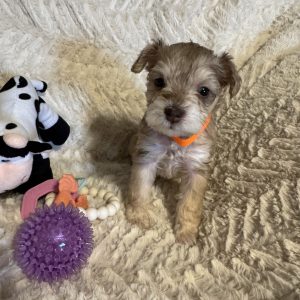Schnauzer
Showing all 4 results

The Schnauzer is a dog breed that was so successful and so desirable, they decided to make three versions. These all-purpose dogs are expert guardians, rat-catchers, and herders were raised to be a farm owner’s loyal companion, and they carry on that legacy until today.
Schnauzers are curious, intelligent, and hard-working dogs who excel at almost any task put in front of them. They enjoy working with their owners and learning new tricks, but they are equally eager to snuggle up to their family members. Their distinctive beards and squared-off build has endeared them to dog lovers around the world, and they are now often kept as house pets.
Temperament
Schnauzers are remarkably self-assured dogs, absolutely secure in their role as the family guardian. Despite this outward confidence, most Schnauzers also possess a deep love for their owners and family members, as well as a hidden playfulness that they reveal for those they really trust. This breed makes an excellent watchdog, as was required of them by their original owners in the 14th and 15th centuries. While they are wary of strangers and will sound the alarm whenever someone new draws close, they don’t tend to be aggressive and are not prone to biting. Their history as rat-catchers and hunting dogs mean they may not get along well with cats or other smaller animals. A well-trained Schnauzer is focused and alert, but also gentle with humans and other dogs. They tend to be calm and well-mannered with new friends, but will show off their goofy, playful side once they’ve warmed up to new people. They’re whip-smart and require consistent rules and boundaries, or else they can take over a household.-

Beautiful AKC miniature schnauzer female pup
-

Jet Black Toy Schnauzer
-

White Chocolate Toy Schnauzer
-

White Chocolate Toy Schnauzer
The Ultimate Guide to Schnauzer
Origins
The Schnauzer can be traced back to Southern Germany in the 14th and 15th centuries. Tradesmen and farmers routinely went to market around the country, and they needed a versatile dog that not only excelled at guarding their wares, but could also fit into the limited space on their carts. These early Schnauzers were likely related to European herding breeds. Eventually, these dogs would be crossed with other German breeds in the 19th century to give the Schnauzer its salt and pepper coloration. By the late 19th century, Schnauzers, originally called Wire-haired Pinschers, began to be exhibited at dog shows. Their name would then eventually change at the turn of the century, owing to the Schnauzer’s distinctive muzzle, or “schnauze” in German. Around World War I, the breed began appearing in the U.S., and soon after the Schnauzer Club of America was formed. The breed’s versatility has made it difficult to classify – it was originally a working breed, then a terrier, then a working breed once again.
Key Characteristics of Schnauzer
| Schnauzer | Schnauzers are remarkably self-assured dogs, absolutely secure in their role as the family guardian. Despite this outward confidence, most Schnauzers also possess a deep love for their owners and family members, as well as a hidden playfulness that they reveal for those they really trust. This breed makes an excellent watchdog, as was required of them by their original owners in the 14th and 15th centuries. While they are wary of strangers and will sound the alarm whenever someone new draws close, they don’t tend to be aggressive and are not prone to biting. Their history as rat-catchers and hunting dogs mean they may not get along well with cats or other smaller animals.
A well-trained Schnauzer is focused and alert, but also gentle with humans and other dogs. They tend to be calm and well-mannered with new friends, but will show off their goofy, playful side once they’ve warmed up to new people. They’re whip-smart and require consistent rules and boundaries, or else they can take over a household. |
| Exercise Needs | Schnauzers are well-built and muscular beneath their salt-and-pepper coat. They were bred as all-around farm dogs and guardians, so they would have been up before the crack of dawn with their masters, working well into the evening. This is an active, high-energy breed with a lot of stamina, and their exercise needs reflect that fact.
While they aren’t the fastest or the most explosively athletic dogs, they’re more than a match for most humans out for a jog. They’ll easily keep up with active owners, and require an hour to an hour and a half of vigorous exercise each day.
They also excel at nosework and other scent-related activities, using their large “schnauze” to their advantage. Agility courses, obedience courses, and other dog sports are all well within the Schnauzer’s skillset, and owners who want a dog that can do it all will be well served by this breed. |
| Schnauzer Grooming | The Schnauzer’s top coat is wiry and dense, with a softer undercoat that keeps the dog warm. This double coat means that the Schnauzer rarely sheds. While they save their owners some effort when it comes to cleaning fur off of the floor, their coat does need regular brushing to prevent mats and tangles.
A weekly brushing is advisable for most Schnauzers, with regular grooming and trimming done every one to two months. The Schnauzer has hair that may grow all the way down to the floor if the owner lets it. Keeping it cut close to the body makes maintenance much easier.
One area where Schnauzer owners must focus their attention is the Schnauzer’s long beard and snout. The hair around this area tends to trap dirt and moisture, which could lead to bacterial infections. Either use a pet wipe or damp towel to clean around the Schnauzer’s snout every couple of days, or wash the face entirely. Towel dry the dog’s face so that they don’t stay damp for too long.
Bathing can be done when the Schnauzer goes in for their regular grooming session, or once every two to three months. Tooth brushing daily is advisable for all sizes of Schnauzer, as they may be prone to tooth and gum problems. Nail trimming can be done either once a month or when the dog gets their hair trimmed. |
| Schnauzer Training | Because they’re so smart, Schnauzers can be trained to do almost anything – whether it be guarding the farm, herding sheep or other animals, or hunting down rodents. However, their self-assured nature may make some Schnauzers more difficult to train. They’re perfectly capable, but they need the proper motivation for their training sessions.
Positive reinforcement and patient training will be the best approach for most Schnauzers, as harsh rebukes and punishment may make them uncooperative. They are sensitive to their owner’s moods and also get bored with repetitive tasks. Short, focused, and fun sessions will be the key to getting your Schnauzer excited for training.
Most Schnauzers will require consistent, life-long training, as they always want new tasks and challenges. The high intelligence of the breed means they need lots of mental stimulation, so other forms of enrichment will be necessary. Slow feeders, dog puzzles, and games will help keep your Schnauzer entertained. |
| Schnauzer Lifespan And Health Issues | Schnauzers are generally healthy dogs and have a relatively long lifespan, with a life expectancy of 13 to 16 years old. Schnauzers may be prone to:
|
| Schnauzer Size And Space Requirements | Schnauzers are a medium-sized breed and were originally prized for their ability to adapt to various environments. Standard Schnauzers will stand between 19 to 20 inches at the shoulder for males, while females will be 18 to 19 inches tall. Male Schnauzers will typically weigh between 35 to 50 pounds, and females will be 30 to 45 pounds.
Most Schnauzers will be able to live comfortably in either urban or rural settings, so long as they are given enough space to run around and exercise.
They prefer to have an outdoor area to explore for their exercise sessions. Due to their high prey drive, they may run off if they spot a squirrel or other small rodent that they can chase, so a secure, fenced yard is ideal. They’re remarkably athletic dogs, and need a fence that is six feet tall or taller, as they’ve been known to scale anything lower.
Schnauzers view themselves as part of the family, and will need to stay in the house with the people under their care. Despite their weather-resistant coat, they dislike living outdoors, because they don’t do well being left alone for long periods of time and want to be part of all family activities. |
Other considerations:
- Schnauzers are often considered to be hypoallergenic, as their double coat will trap fallen hair. However, people with dog allergies may still be allergic to the Schnauzer’s saliva or dander.
- There are three Schnauzer sizes: the Standard Schnauzer, the Miniature Schnauzer, and the Giant Schnauzer.
- Schnauzers may be prone to benign bumps on their skin, a condition known as Schnauzer comedo syndrome.
How can I take good care of my Schnauzer or Puppy?
Proper socialization
Schnauzer puppies require socialization at an early age so that they get along with strangers and other dogs. Because the breed is naturally wary, they must learn early on that not everyone is a threat. As soon as you bring your Schnauzer puppy home, you can begin doing socialization work to introduce them to new experiences and situations. Doing this early, along with training, can help prevent bad habits and behaviors from forming.
Proper nutrition
The Miniature Schnauzer, Standard Schnauzer, and Giant Schnauzer should all be given high-quality, premium dog food to encourage proper growth and development. You may ask your veterinarian for more specific recommendations for your Schnauzer puppy, as their needs may be different from other Schnauzers.
Up-to-date vaccinations
Upon bringing home your Schnauzer puppy, you may contact your veterinarian for more specific advice regarding a vaccination schedule. The exact timeframes may differ depending on your puppy’s health, the vaccine products being used, and other factors. Follow the schedule the veterinarian gives you to the best of your ability so that your puppy is protected.
Most Asked Schnauzer Questions
-
+How Much do Schnauzer Puppies Cost